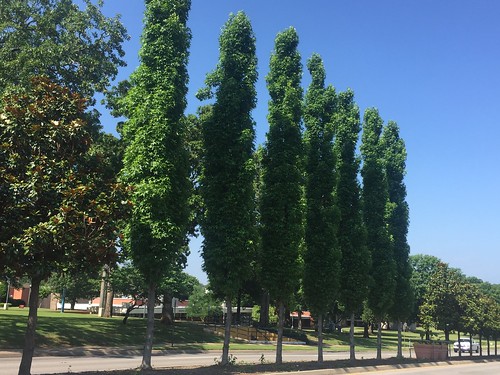Resource Library
Plant of the Week: Liquidambar styraciflua “Slender Silhouette”; Columnar Sweetgum
Identifying trees while driving down the road is one of the ways we plant nerds entertain ourselves. On a recent trip to Fort Smith, I had to pull over when I saw a planting of pencil-thin trees growing in the median in front of the University of Arkansas Fort Smith campus. The tree turned out to be Slender Silhouette sweetgum (Liquidambar styraciflua ‘Slender Silhouette’).
Sweetgum, now classified as belonging to its own family, needs little introduction to Arkansans. It is the most common hardwood tree throughout the southern states but it once had a much wider range. Sweetgum ancestors first made their appearance about 95 million years ago, reaching maximum distribution over much of the northern hemisphere about 55 million years back. Fossil records are found in Greenland, Colorado, Washington state and throughout Europe. Today about 15 species are recognized as remnant stands here, in the Yucatan of Mexico, the Eastern Mediterranean region (especially Turkey) and Southeastern China.
The American sweetgum is a bottomland species commonly growing 75 feet in height with a more or less pyramidal form. Slender Silhouette is a beanpole of a plant, growing 50 feet tall or higher, with a spread of 5 feet at the base. It maintains a remarkable degree of uniformity as it grows upward with the top of the column about the same width as the base.
Its glossy, dark green, star shaped leaves take on an unpredictable array of colors in the fall, ranging from clear yellow to orange, red or burgundy. Slender Silhouette trees I have seen in the fall had orange-red fall color, but Michael A. Dirr, the well-known landscape writer, says they are yellow with a hint of red.
Now about the balls. Many Arkansans hate the inch-and-a-half gum balls with a passion normally reserved for ticks, mosquitos and Texas football teams. Slender Silhouette is often touted as being a fruitless variety but that is probably more wishful thinking than reality. The tree will produce fruit, but its gum ball production is more erratic than that of typical wild trees.
Slender Silhouette was discovered growing wild along a railroad track near Don Shadow’s Franklin County, Tennessee nursery sometime before the turn of the century. Shadow, a fourth-generation nurseryman and plantsman extraordinaire, has a keen eye for spotting new and useful plants and, over his 50-year career, has been the source of many find introductions.
Shadow has always been interested in the natural world and has amassed a collection of rare plants and animals from throughout the world. His animal collection – consisting of as many as 800 specimens – includes about 60 species. His goal is to conserve rare animals and breeds that could be threatened with extinction. He shares the offspring of his menagerie with zoos throughout the country.
Fastigiate plants such as Slender Silhouette sweetgum have the dramatic form and widespread adaptation that makes it a natural for inclusion in modern day urban settings where lot sizes are shrinking and neighbors are getting closer. They can be used as accent points in the landscape or for a tall screen planting.
Sweetgums are hardy from zones 5-9. They tolerate a wide array of soil conditions and grow quickly as young trees. They should not be planted in shaded sites.
For more information about horticulture or to see other Plant of the Week columns, visit Extension’s Website, www.uaex.uada.edu, or contact your county extension agent. The Cooperative Extension Service is part of the U of A Division of Agriculture.
